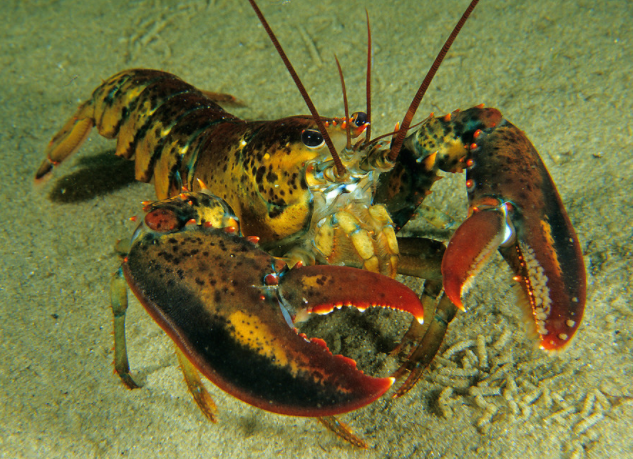Coming up on Jonathan Bird's Blue World, Jonathan meets some big lobsters.
接下来是乔纳森·伯德的蓝色世界,乔纳森遇到了一些大龙虾。
All of this today on Jonathan Bird's Blue World!
这就是我们今天的节目内容!
Hi, I'm Jonathan Bird and welcome to my world!
大家好,我是乔纳森·伯德,欢迎来到我的世界!
The American Lobster may not look all that tasty,
美洲龙虾可能看起来不那么美味,
but this large crustacean that was once considered a nuisance by catch is now considered a delicacy around the world.
但是曾经令人生厌的大型甲壳类动物现在却被世界各地的人认为是一种美味。
Although they are shipped to restaurants everywhere, they come from the cold waters of the North Atlantic,
龙虾虽然被运往各地的餐馆,但它们生存在北大西洋冰冷的海水中,
mostly from New England and Eastern Canada.
大部分来自新英格兰和加拿大东部。
I want to find a really big lobster,
为找寻大龙虾,
so I've come to Eastport, Maine, right on the Canadian border to hunt for a monster!
我来到缅因州的伊斯特波特(加拿大的边境)!
Lobsters hunt at night, so they like to hide in holes in the rocks during the day.
龙虾晚上捕食,喜欢白天躲在岩洞里。
This is what you normally see of a lobster during the day—just a couple of claws sticking out of its den.
白天的龙虾就是这个样子——只有几个爪子从巢穴伸出来。
With some gentle prodding, the lobster will come out to defend its turf.
只要轻轻一戳,龙虾就会出来保卫自己的地盘。
Lobsters are extremely territorial and often fight each other for prime dens.
龙虾具有极强的地盘意识,经常为了争夺最佳的巢穴而互相争斗。
I have to be very careful of the claws.
我得小心爪子。
If this lobster gets hold of my hand or fingers it can easily break them.
如果龙虾抓住我的手或手指,就能轻易撕破。
Note that this lobster has a larger claw on the left side.
请注意,这只龙虾的左爪较大。
This is called the crusher claw.
我们把它叫做破碎钳。
The other is the pincher or ripping claw.
另一种是蝎钳。
The crusher claw tells us this lobster is left-handed...er---clawed.
破碎钳告诉我们这只龙虾是左撇子。
When a lobster gets this big, it demands respect!
当龙虾长到这么大的时候需要尊重!
Maine is the lobster capital of the US,
缅因州是美国的龙虾之都,
and Boothbay harbor is one of the most popular places to visit if you want a fresh lobster dinner.
如果你想要吃新鲜的龙虾,布斯湾港是绝佳之地。
It's also the home of the Maine State Aquarium, where I'm learning a little bit about the life cycle of lobsters.
布斯湾港也是缅因州水族馆的所在地,我在这里对龙虾的生活有了一些了解。
I'm venturing behind the scenes in the Bigelow Laboratory where they conduct research on lobsters.
我正在比奇洛海洋科学实验室,他们在此研究龙虾。
Researcher Aimee Hayden-Roderigues introduces me to some of the unusual lobsters in their collection.
研究员Aimee Hayden-Roderigues向我介绍了他们收集的一些非同寻常的龙虾。

Now most lobsters are not red - that's the color they are when they're cooked.
现在的大多数龙虾都不是它们烹饪时的颜色——红色。
In the wild, lobsters are more this color, sort of an olivey color, maybe with a little bit of green and some orange.
野生龙虾更多的是带点橄榄色,可能有一点绿色和一些橙色。
Now, every once in a while, however, you'll come across a lobster that looks like this.
然而,每隔一段时间,你就会遇到这样的龙虾。
This blue coloration is an extremely rare pigmentation found one in every three million lobsters.
这种蓝色是一种极为罕见的色素沉着,每300万只龙虾中就有一只龙虾是这种颜色。
And I have to say, they are cool!
我不得不说,它们很酷!
Now, if you want to talk about rare genetic variations, this one takes the cake.
现在,如果你要说罕见的基因变异,这只龙虾就是。
This one is called a bi-color lobster and you can see that the color is divided right down the middle,
这只叫做双色龙虾,你可以看到颜色从中间分开,
one side's blue and the other side's kind of a pale yellow.
一边是蓝色,另一边是浅黄色。
These bi-color lobsters are so rare only one in every 100 million of these are born this color.
这种双色龙虾非常罕见,每一亿只龙虾中只有一只出生就是这种颜色。
That is one rare lobster.
那是一只稀有龙虾。
This female lobster has something very special going on.
这只雌性龙虾有非常特别的地方。
If you look underneath her tail, it's full of eggs.
你从它的尾巴下面可以看到,里面全是卵。
The female incubates thousands of eggs under her tail for up to a year before they hatch,
雌龙虾尾巴下的成千上万只卵得孵1年。
and then when it's time for them to hatch, she releases the eggs out into the water,
到了破壳而出的时候,她把这些卵放进水里,
they hatch with little larvae that swim off into the water to become planktonic lobsters.
这些幼体龙虾游到水里变成浮游龙虾。
Lobsters don't grow very quickly, and just to give you an example,
龙虾长得不是很快,举个例子,
this is about a one-month old lobster, just old enough that it has settled down to the bottom after being plankton.
这是一只大约一个月大的龙虾,只是到了浮游龙虾沉入海底的年龄。
But from this to the next phase...takes a long time.
但是从这个阶段到下一个阶段……需要很长时间。
This little guy - HEY - this little guy is between a year and two years old.
这只小龙虾—HEY—大概一两岁。
It takes a long time for a lobster just to reach this size, and this is nowhere near market-size yet.
龙虾长到这个大小需要很长时间,而且还远没有达到市场大小。
Incidentally, they pinch...
顺便说一句,他们太小…
Now this one...this one is just barely old enough to be a legal lobster for a lobsterman to catch,
现在这只…这只龙虾刚刚到了法定捕捉的年龄,
and it's probably seven years old.
它大概有7岁。
So it takes seven years just for a lobster to big enough to catch,
一只龙虾需要7年的时间才能长到捕捉的大小,
so you can imagine how long it takes for those really big ones to get three feet long.
所以你可以想象那些真正的大龙虾要花多长时间才能长到三英尺。
A few hundred years ago, lobsters were incredibly abundant.
几百年前,龙虾数量多得令人难以置信。
In fact, after a big storm, the beaches would be covered in lobsters washed up by the waves.
实际上,暴风雨过后,海滩上到处都是被海浪冲上岸的龙虾。
Back then, lobsters were considered cheap food for poor people. How times change!
当时,龙虾被认为是穷人的廉价食物,时代变了!
Lobstermen catch lobsters using a simple trap,
捕虾人用简单的工具捕捉龙虾,
the design of which hasn't changed much in a hundred years.
工具的设计一百年来变化不大。











